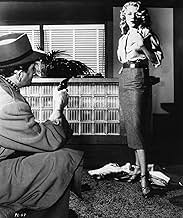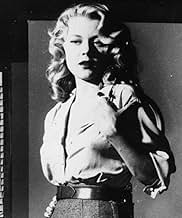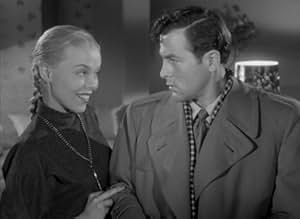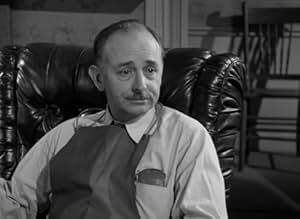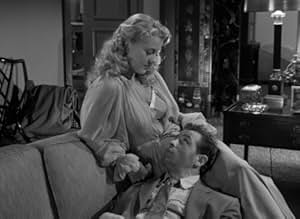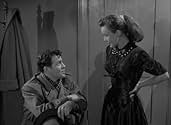Ajouter une intrigue dans votre langueDectective Mike Hammer is determined to catch and kill the person who shot his close friend dead, so he follows clues that lead to a beautiful, seductive woman.Dectective Mike Hammer is determined to catch and kill the person who shot his close friend dead, so he follows clues that lead to a beautiful, seductive woman.Dectective Mike Hammer is determined to catch and kill the person who shot his close friend dead, so he follows clues that lead to a beautiful, seductive woman.
- Hal Kines
- (as Robert Cunningham)
- Esther Bellamy
- (as Tani Seitz)
- Mary Bellamy
- (as Dran Seitz)
- Undetermined Secondary Role
- (unconfirmed)
Avis en vedette
On the plus side, the movie was photographed by John Alton. He makes the most of the cheap production values. Good use of the Bradbury Building, which is recognizable to fans of films like D.O.A. and Blade Runner. Nice score from Franz Waxman. The supporting cast includes many lesser known actors but there are a few old pros like Preston Foster, John Qualen, and Elisha Cook, Jr. How any of them kept a straight face while that sack of meat was barking at them is beyond me. Attractive Peggie Castle makes an unconvincing psychologist and is even less convincing as a woman attracted to Elliot.
This movie has a lot that prevents it from being great. But all of the other issues combined don't equal the sheer ineptitude of casting Biff Elliot as Mike Hammer. This was his film debut and he never did anything this big again. He worked fairly steady for decades, mostly in television. I have no idea why he was cast. Worked cheap? Saved the producer's life? Knew where the bodies were buried? I don't know. All I do know is he stinks in this.
I, the Jury concerns Mike Hammer's search for the killer of his friend, Jack. Eventually other people who attended the same party as Jack are killed as well.
From what I gather, this was shown in 3-D some time in 2003, with the star, Biff Elliott (then 80) present. The audience loved it - mainly because all the dialogue is now considered "camp."
One thing Elliot could do was beat up people, since he had previously been a boxer. Just no dimension to the character. I would have loved to have seen someone like Ralph Meeker in this film.
Of note was the very neat opening scene, which I imagine played very well in 3-D. The last scene of the film was very effective as well.
The women in the movie were lovely - Mary Anderson does a good job as Eileen Vickers. Margaret Sheridan was a lovely Velda, and Peggie Castle was a stunning Charlotte, one of the many women in love with Mike. The other performances were okay.
As the first film Mike Hammer, one would assume it brought Elliot attention and, in other hands, could have been a star-making role. Though he continued working for years, it wasn't as a star. Sadly I think better casting would have helped "I, The Jury" immensely.
These echoes may have been attempts to invest Hammer with some respectability, linking him to the more subtle and textured characters of the 1940s. It's clear something had to be done with him, because Spillane went for raw sensation in a way that caused a sensation of its own. His private eye is uncouth, short-fused and randy but misogynist, bowing to no authority save his own (hence the title). Spillane luckily or shrewdly had as readers of his punch-drunk prose men who had survived overseas combat and were making up for lost time in the footloose, post-war prosperity; he gave them not just sex and violence but sex-and-violence.
So in one sense, Biff Elliott makes an ideal Hammer, closer to Spillane's lout than his (relatively) spruced-up successors Ralph Meeker and Robert Bray (plus Armand Assante, in the marginally better 1982 remake of this title). He comes across as a Dead End kid grown up with a license and a gun, slow-witted but fast with his fists and his trigger.
When his best friend, an insurance investigator and combat amputee, gets himself coldly killed, Hammer scours New York to avenge him. The urban locales bring out the talents of director of photography John Alton, who here tried his hand at the 3-D process (thus I, The Jury, along with Man in the Dark, The Glass Web and Second Chance, becomes one of the few noirs so filmed).
The shoot-from-the-hip action, however, rides roughshod over any intricacies of the plot. Characters Hammer encounters stay generic, with the exception of Peggie Castle as the shrink. The film's last scene is hers, not Elliott's, as she moves into a languorous striptease that comes to a quick finale. For better or worse, it's an emblematic image that showcases Spillane's coarsened sensibility, his fusion of brutality and eroticism, and spells an end to the more freighted ambiguity that was a hallmark of the noir cycle.
No "tricks" here like a fire torch splashed into the camera eye. Any 3D detractor should watch this movie. Not the usual 3D method of emphasizing certain elements and relegating others was employed but all of them are in relief instead. The opening scene with the firing gun is maybe the only license to that use. The result it is an exciting watching experience that brings the whole set to life by highlighting every single element. 3D experience upgraded.
As for the cast, Biff Elliot plays decently although wooden a tough, rude and violent Mike Hammer, boxer- type (he had been a boxer himself in his youth). Peggie Castle plays a psychoanalyst and does an excellent femme fatale, Preston Foster has a small but solid role as a police captain and Margaret Sheridan is the ever- efficient Hammer secretary (Perry Mason's Della Street type). Role of the dead man was played by real life single -handed Robert Swanger in his only screen appearance.
Based on Mickey Spillane's book I, the jury some facts were changed - cocaine traffic to jewelry smuggling, twin sisters' nymphomania and Hammer's final shot from spontaneous to in response to be almost killed.
Special mention for the 3D-inside-3D view-master type shot surprise gem. This scene only makes the movie worth watching in 3D only and an enjoyable experience for any 3D and view master fan. Do not miss it.
Le saviez-vous
- AnecdotesOriginally filmed in 3D, but by the time it opened, 3D had lost favor among audiences, and many first-run engagements, as well as most second-run engagements, opted to offer it in the standard 2D version.
- GaffesAt Manuel's Spanish-American Bar, Manuel serves Mike Hammer a glass of beer that is at least half-head with a foamy dome extending above the top of the glass. With an instant viewing angle change, the head on the beer is no more than an inch tall with its top level with the top of the glass. Again at the original viewing angle the beer has the thick head with the dome above the top of the glass. With yet another angle change, the head is short, not even extending to the top of the glass.
- Citations
[last lines]
Mike Hammer: [after he shoots Charlotte as he knew she was going to shoot him] So long baby.
Charlotte Manning: How could you...
[Charlotte slowly and sultrily crumples to the floor in her death]
Mike Hammer: It was easy.
[Mike heads to the telephone]
Mike Hammer: [voice over] There was only one thing left to do. Order a basket... a real pretty one. And wait for Pat. He had his killer, and I had my memories.
- ConnexionsFeatured in The Witching Hour: I, The Jury (1958)
Meilleurs choix
- How long is I, the Jury?Propulsé par Alexa
Détails
- Date de sortie
- Pays d’origine
- Langues
- Aussi connu sous le nom de
- Der Richter bin ich
- Lieux de tournage
- Los Angeles, Californie, États-Unis(Mike Hammer's office at the Bradbury Building at the corner of Broadway and W. Third Street)
- société de production
- Consultez plus de crédits d'entreprise sur IMDbPro
Box-office
- Brut – États-Unis et Canada
- 1 400 000 $ US
- Durée1 heure 27 minutes
- Couleur
- Rapport de forme
- 1.37 : 1
Contribuer à cette page



